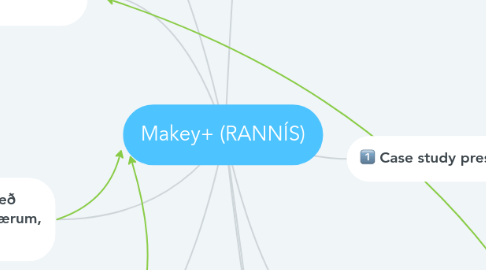Makey+ (RANNÍS)
af Solveig Jakobsdottir


1. MakEY-Mooc for Icelandic educators?
2. FAB-LAB í VMA
2.1. SólveigZ
2.2. Upper secondary school learners
2.3. Makey non-case
3. Snjallvagn (með forritunarverkefærum, þjarkar)
3.1. Sólveig Z, miðstöð skólaþróunar
3.2. Interaction between learners
3.3. Link to Deborah Fablab Berlin
4. Forritun og vefsmíði Umhverfi fyrir börn og ungmenni Scratch forritunarmál og önnur myndræn tól sem verkfæri til að stýra og forrita IoT hluti.
4.1. Salvör
5. Using TinkerCad to Enable Crafting in a Virtual Makerspace: a Case Study
5.1. Gísli og Skúlína
6. Vexa:
6.1. Teymi
6.1.1. Svava
6.1.2. Torfi
6.1.3. Skúlína
6.2. Participants
6.2.1. A group of seven female educators (Hildur, Rósa, Hugrún, Þorbjörg St., Bjarndís, Anna María, Erla)
6.2.2. 4 grunnskólar: Garða-, Grundarfj., Hólabrekku, Norðlingask.
6.3. Acitvities
6.3.1. Mobile makerspace/ Tækni kit
6.3.2. professional development courses
6.3.3. Online portal/UT-torg
6.3.4. 4 grunnskólar: Garða-, Grundarfj., Hólabrekku, Norðlingask.
6.4. Mixed methods
6.4.1. Group inteviews
6.4.2. Individual inteviews
6.4.3. Analysis of online communication and content
7. Artists and other technology pioneers as a driving force of youth & childrens’ makerspace workshops in Iceland
7.1. SHK, MEO
7.2. 1. artists and technology pioneers that have organised maker workshops for youth and children on digital art, media creations and other creative activities. 2. Institutions (museums and library) collaborators. 3. Children (pre-school and primary school age) and their parents/guardians, taking part in workshops organised by artists and technology pioneers.
7.3. Qualitative methods: Interviews - with artists and technology pioneers, children in workshops Event/workshop observations with video documentation, registering the character of the makerspace, learning designs, objectives and activites. 1st person perspective videoing with GoPro cameras, observing creation and skill development. Participatory collection (contributed by artists, technology pioneers, museum & library staff, children) of data: event documentation and images, and learning outcomes, relating to former events and workshops during the project period. Internet research methods will be employed to register community actions and communications.
7.4. Data collection consists of interview data (sound files, video files), internet resources, documentation on development of artists movement and news items relevant to the research. Images or videos of children working in events and workshops, with documentation of learning designs & outcomes, objects, texts or media artifacts created by participants.
8. Pedagogy of INNOENT maker spaces: The role of learner agency in creative processes
8.1. Svanborg
8.2. Links to Finland
9. Case study preschool
9.1. 4 preschools. Follow and supporting 4 preschools, implementing makerspaces.
9.2. Team
9.2.1. Kristín, Anna Elísa
9.2.2. Kristín, Anna Elísa
9.3. Participants
9.3.1. 4 preschools
9.3.1.1. Preschools invited to participate
9.4. Activites
9.4.1. Workshops, professional development
9.4.2. Implementing makerspaces
9.5. Methods
9.5.1. Mixed methods,
